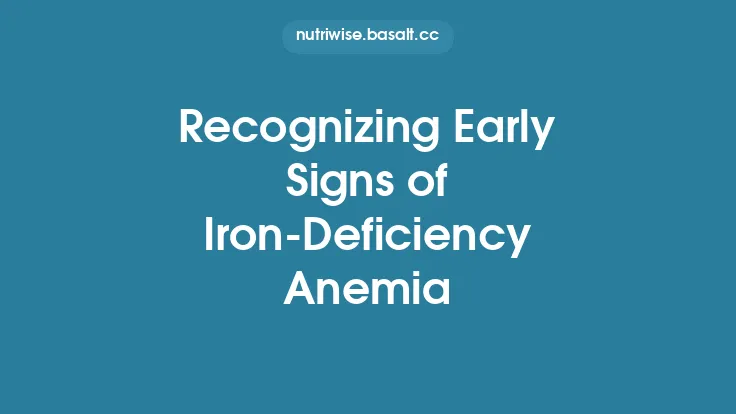Micronutrients—vitamins, minerals, and trace elements—are the tiny powerhouses that keep every cell, tissue, and organ functioning smoothly. Because the body stores only limited amounts of most of these compounds, a shortfall can begin to affect physiological processes long before a full‑blown deficiency disease appears. Recognizing the early warning signs gives you the chance to intervene before damage becomes irreversible.
Understanding Micronutrient Deficiency
Micronutrients differ from macronutrients (carbohydrates, proteins, fats) in that they are required in milligram or microgram quantities, yet they serve as essential cofactors for enzymes, structural components of tissues, and regulators of gene expression. When intake or absorption falls below the body’s minimal needs, the first impact is usually on systems that have the highest turnover rates—skin, hair, blood, and the nervous system. Early signs are therefore often subtle changes in appearance, energy levels, or minor functional disturbances that may be dismissed as “just stress” or “normal aging.”
The biochemical basis of these early manifestations typically involves:
- Reduced enzyme activity – many vitamins act as co‑enzymes; a slight deficit can slow metabolic pathways.
- Altered hormone synthesis – minerals such as iodine and zinc are critical for thyroid and insulin regulation.
- Compromised antioxidant defenses – vitamins C, E, and selenium protect cells from oxidative stress; early depletion leads to increased cellular fatigue.
- Impaired cellular turnover – vitamin A and B‑complex vitamins are vital for epithelial renewal; deficiency shows up first in skin and mucous membranes.
Because the body prioritizes vital functions, it reallocates limited micronutrients to essential organs (brain, heart) at the expense of peripheral tissues, creating a cascade of early warning signals.
General Physiological Red Flags
While each micronutrient has its own signature, several systemic clues recur across multiple deficiencies:
| Early Sign | Typical Underlying Mechanism |
|---|---|
| Unexplained fatigue or reduced stamina | Diminished mitochondrial efficiency due to insufficient B‑vitamins (B1, B2, B3) and iron, leading to lower ATP production. |
| Pale or slightly yellowish skin | Early iron or vitamin B12 shortage reduces hemoglobin synthesis, causing a subtle drop in red‑cell count. |
| Dry, flaky, or rough skin | Inadequate vitamin A or essential fatty acid‑linked micronutrients impair keratinocyte differentiation. |
| Brittle nails or spoon‑shaped (koilonychia) nails | Early iron deficiency interferes with nail matrix protein synthesis. |
| Hair that feels thinner or sheds more than usual | Micronutrients involved in keratin production (zinc, biotin, vitamin D) are depleted, weakening hair follicles. |
| Mild tingling or “pins‑and‑needles” sensations | Early vitamin B6 or B12 deficits affect myelin formation, leading to peripheral nerve irritability. |
| Increased susceptibility to colds or prolonged recovery | Suboptimal vitamin C, zinc, or selenium levels weaken innate immune responses. |
| Frequent muscle cramps or spasms | Low magnesium or calcium disrupts neuromuscular excitability. |
These signs are not diagnostic on their own, but when they appear together or persist, they form a pattern that points toward a micronutrient shortfall.
Vitamin‑Specific Early Indicators
Vitamin A (Retinol & Carotenoids)
- Conjunctival dryness – the eyes may feel gritty; the sclera can appear slightly pale.
- Mild hyperkeratosis – rough patches on the elbows or knees.
- Reduced night vision acuity – difficulty adapting to low‑light environments before full night‑blindness develops.
B‑Complex Vitamins
- Thiamine (B1): Early irritability, loss of appetite, and subtle memory lapses.
- Riboflavin (B2): Cracked corners of the mouth (angular cheilitis) and a bright yellowish hue to the tongue.
- Niacin (B3): Flushing that occurs with warm drinks or after a shower, often mistaken for a skin reaction.
- Pyridoxine (B6): Mood swings and mild depression, sometimes accompanied by a slight rash around the neck.
- Cobalamin (B12): Slightly elevated homocysteine levels (detectable in routine blood work) and a subtle tingling in the fingertips.
Vitamin C (Ascorbic Acid)
- Gingival tenderness – gums may bleed slightly with brushing.
- Delayed wound healing – small cuts take longer to close.
- Mild bruising – capillary fragility leads to easy bruises on the forearms.
Vitamin D (Calciferol)
- Bone tenderness – especially in the lower back or hips after prolonged sitting.
- Mild mood changes – low‑grade depressive symptoms, often seasonal.
- Reduced calcium absorption – early signs include occasional muscle twitches.
Vitamin E (Tocopherol)
- Increased oxidative stress markers – subtle skin discoloration or a “sallow” complexion.
- Mild peripheral neuropathy – similar to early B‑vitamin deficiency but with a more pronounced burning sensation.
Vitamin K
- Prolonged clotting time – minor nosebleeds or easy bruising that does not resolve quickly.
- Subtle changes in bone turnover – detectable only through specific biomarkers, but may manifest as early joint stiffness.
Mineral‑Specific Early Indicators
Iron
- Pale conjunctiva – the inner eyelid appears lighter than usual.
- Restless legs – an early neurological manifestation of iron shortage.
- Reduced exercise tolerance – shortness of breath after climbing a single flight of stairs.
Calcium
- Occasional muscle cramps – especially at night.
- Numbness or tingling around the mouth – early signs of altered calcium homeostasis.
- Mild osteopenic changes – detectable on a bone density scan before osteoporosis.
Magnesium
- Transient anxiety or irritability – magnesium modulates NMDA receptors.
- Slight tremor in the hands – fine tremor that disappears at rest.
- Irregular heartbeats – occasional premature beats noted on a routine ECG.
Zinc
- Loss of taste or smell – subtle reduction in flavor perception.
- Dermatitis around orifices – small, red, scaly patches near the mouth and eyes.
- Delayed growth in children – slower height increase compared to peers.
Selenium
- Mild muscle weakness – especially after prolonged activity.
- Hair that loses its luster – early signs of oxidative damage.
- Increased oxidative markers – detectable in blood but not yet causing clinical disease.
Iodine
- Slightly enlarged thyroid (goiter) – a palpable fullness at the base of the neck.
- Cold intolerance – feeling chilly even in moderate temperatures.
- Mild cognitive slowing – subtle difficulty concentrating.
Interconnected Systems: How Early Deficiencies Manifest Across Body Networks
Micronutrients rarely act in isolation; their pathways intersect, creating overlapping symptom clusters:
- Hematologic System: Iron, B12, folate, and copper all influence red‑cell production. Early anemia may present as a combination of pallor, fatigue, and mild tachycardia.
- Immune System: Vitamin C, zinc, selenium, and vitamin D each modulate innate and adaptive immunity. A pattern of frequent colds, slower wound healing, and mild skin infections can signal a collective shortfall.
- Neurological System: B‑vitamins, magnesium, and omega‑3‑linked micronutrients (e.g., DHA) support neurotransmitter synthesis. Early cognitive fog, irritability, or peripheral tingling often reflects a multi‑nutrient imbalance.
- Dermatologic System: Vitamin A, biotin, zinc, and essential fatty acids maintain skin barrier integrity. Dryness, scaling, or acne‑like eruptions may be the first visible clue.
Understanding these networks helps clinicians and readers connect seemingly unrelated signs to a common micronutrient origin.
Laboratory Clues That Hint at Early Deficiency
Even before a full diagnostic work‑up, routine blood panels can reveal early imbalances:
| Test | What It Suggests When Slightly Abnormal |
|---|---|
| Complete Blood Count (CBC) – Hemoglobin, Hematocrit, MCV | Mild microcytic or macrocytic trends point to iron, B12, or folate insufficiency. |
| Serum Ferritin (low‑normal) | Early iron depletion before anemia manifests. |
| Serum 25‑Hydroxy Vitamin D (20–30 ng/mL) | Insufficient vitamin D status, increasing risk for bone and immune changes. |
| Serum Magnesium (borderline low) | May precede neuromuscular symptoms. |
| Serum Zinc (low‑normal) | Correlates with taste changes and skin lesions. |
| Thyroid Stimulating Hormone (TSH) (slightly elevated) | Early iodine deficiency affecting thyroid function. |
| Plasma Homocysteine (elevated) | Early B‑vitamin (B6, B12, folate) deficiency. |
| C‑Reactive Protein (CRP) (mildly raised) | May reflect oxidative stress linked to low vitamin E or selenium. |
These values are not definitive diagnoses but serve as early alerts that warrant a more focused nutritional assessment.
When to Seek Professional Evaluation
Because early signs can be easily attributed to lifestyle factors or transient illnesses, it is essential to recognize thresholds that merit medical attention:
- Persistence: Symptoms lasting more than 4–6 weeks without clear cause.
- Progression: Signs that gradually intensify (e.g., increasing hair loss, worsening fatigue).
- Combination: Multiple early signs appearing together, especially across different systems (e.g., fatigue + skin changes + tingling).
- Laboratory Abnormalities: Even borderline lab results, when coupled with clinical signs, should prompt a targeted micronutrient panel.
- Impact on Daily Function: Any symptom that interferes with work, study, or routine activities.
A healthcare professional can order specific assays, evaluate dietary patterns, and rule out underlying medical conditions that may mimic micronutrient deficiency.
Summary of Key Early Warning Signs
- Fatigue and reduced stamina – often the first clue of B‑vitamin or iron shortfall.
- Pale or yellowish skin – early iron or B12 deficiency.
- Dry, rough skin or flaky patches – low vitamin A or essential fatty‑acid‑linked micronutrients.
- Brittle or spoon‑shaped nails – iron depletion.
- Thinning hair or increased shedding – zinc, biotin, vitamin D insufficiency.
- Mild tingling, numbness, or “pins‑and‑needles” – early B6/B12 or magnesium deficiency.
- Frequent colds, slow wound healing, or easy bruising – vitamin C, zinc, selenium, or vitamin K shortfall.
- Muscle cramps, spasms, or nighttime leg twitches – calcium or magnesium deficiency.
- Conjunctival dryness, night‑vision difficulty – early vitamin A deficiency.
- Gingival tenderness or bleeding – vitamin C insufficiency.
- Restless legs or occasional heart palpitations – iron or magnesium depletion.
- Slight goiter or cold intolerance – iodine deficiency.
Recognizing these early signals empowers you to act promptly, ensuring that micronutrient status is restored before more serious health consequences arise.





